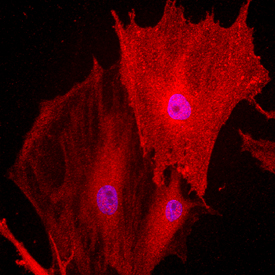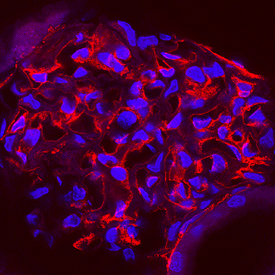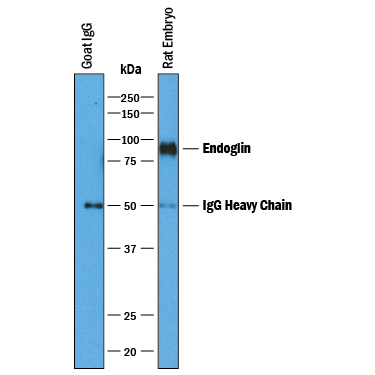Rat Endoglin/CD105 Antibody Summary
Met1-Gly578
Accession # Q6Q3E8
Applications
Please Note: Optimal dilutions should be determined by each laboratory for each application. General Protocols are available in the Technical Information section on our website.
Scientific Data
 View Larger
View Larger
Detection of Rat Endoglin/CD105 by Western Blot. Western blot shows lysates of rat kidney tissue. PVDF membrane was probed with 1 µg/mL of Goat Anti-Rat Endoglin/CD105 Antigen Affinity-purified Polyclonal Antibody (Catalog # AF6440) followed by HRP-conjugated Anti-Goat IgG Secondary Antibody (Catalog # HAF017). A specific band was detected for Endoglin/CD105 at approximately 90 kDa (as indicated). This experiment was conducted under reducing conditions and using Immunoblot Buffer Group 1.
 View Larger
View Larger
Endoglin/CD105 in Rat Mesenchymal Stem Cells. Endoglin/CD105 was detected in immersion fixed undifferentiated rat mesenchymal stem cells using Goat Anti-Rat Endoglin/CD105 Antigen Affinity-purified Polyclonal Antibody (Catalog # AF6440) at 10 µg/mL for 3 hours at room temperature. Cells were stained using the NorthernLights™ 557-conjugated Anti-Goat IgG Secondary Antibody (red; Catalog # NL001) and counterstained with DAPI (blue). Specific staining was localized to the transmembrane. View our protocol for Fluorescent ICC Staining of Stem Cells on Coverslips.
 View Larger
View Larger
Endoglin/CD105 in Rat Kidney. Endoglin/CD105 was detected in perfusion fixed frozen sections of rat kidney using Goat Anti-Rat Endoglin/CD105 Antigen Affinity-purified Polyclonal Antibody (Catalog # AF6440) at 1 µg/mL overnight at 4 °C. Tissue was stained using the NorthernLights™ 557-conjugated Anti-Goat IgG Secondary Antibody (red; Catalog # NL001) and counterstained with DAPI (blue). Specific staining was localized to endothelial cells in glomeruli. View our protocol for Fluorescent IHC Staining of Frozen Tissue Sections.
 View Larger
View Larger
Immunoprecipitation of Rat Endoglin/CD105. Endoglin/CD105 was immunoprecipitated from 400 µg of rat embryo tissue lysates using 4 µg of Goat Anti-Rat Endoglin/CD105 Antigen Affinity-purified Polyclonal Antibody (Catalog # AF6440) coated on 4 wells of a 96 well plate (Corning Costar EIA/RIA). Rat embryo tissue lysates or control buffer were added to the wells and incubated for 2 hours at room temperature. Immunoprecipitated Endoglin/CD105 was detected by Western blot under reducing conditions using 1 µg/mL Goat Anti-Rat Endoglin/CD105 Antigen Affinity-purified Polyclonal Antibody (Catalog # AF6440) and Immunoblot Buffer Group 1. View our recommended buffer recipes for Immunoprecipitation.
Reconstitution Calculator
Preparation and Storage
- 12 months from date of receipt, -20 to -70 °C as supplied.
- 1 month, 2 to 8 °C under sterile conditions after reconstitution.
- 6 months, -20 to -70 °C under sterile conditions after reconstitution.
Background: Endoglin/CD105
Endoglin (CD105) is a 90 kDa type I transmembrane glycoprotein of the zona pellucida (ZP) family of proteins. Endoglin and betaglycan/T beta RIII are type III receptors for TGF-beta superfamily ligands, sharing 71% aa identity with the transmembrane (TM) and cytoplasmic domains. Endoglin is highly expressed on proliferating vascular endothelial cells, chondrocytes, and syncytiotrophoblasts of term placenta, with lower amounts on hematopoietic, mesenchymal and neural crest stem cells, activated monocytes, and lymphoid and myeloid leukemic cells. Rat Endoglin cDNA encodes 650 amino acids (aa) including a 25 aa signal sequence, a 553 aa extracellular domain (ECD) with an orphan domain and a two-part ZP domain, a TM domain and a 51 aa cytoplasmic domain. In human and mouse, an isoform with a 14 aa cytoplasmic domain (S‑endoglin) can oppose effects of long (L) Endoglin. In rat, a potential isoform with a 100 aa cytoplasmic tail (49 aa inserted after aa 610) diverges at the same aa as S‑endoglin. The rat Endoglin ECD shares 84%, 70%, 68%, 64%, and 62% aa identity with mouse, human, canine, porcine, and bovine Endoglin, respectively. Endoglin homodimers interact with TGF-beta 1 and TGF-beta 3 (but not TGF-beta 2), but only after binding T beta RII. Similarly, they interact with activin-A and BMP-7 via activin type IIA or B receptors, and with BMP-2 via BMPR-1A/ALK-3 or BMPR-1B/ALK-6. BMP-9, however, is reported to bind Endoglin directly. Endoglin modifies ligand-induced signaling in multiple ways. For example, expression of Endoglin can inhibit TGF-beta 1 signals but enhance BMP7 signals in the same myoblast cell line. In endothelial cells, Endoglin inhibits T beta RI/ALK-5, but enhances ALK‑1‑mediated activation. Deletion of mouse Endoglin causes lethal vascular and cardiovascular defects, and human Endoglin haploinsufficiency can cause the vascular disorder, hereditary hemorrhagic telangiectasia type I. These abnormalities confirm the essential function of Endoglin in differentiation of smooth muscle, angiogenesis, and neovascularization. In preeclampsia of pregnancy, high levels of proteolytically generated soluble Endoglin and VEGF R1 (sFLT1), along with low placental growth factor (PlGF), are pathogenic due to anti-angiogenic activity.
Product Datasheets
FAQs
No product specific FAQs exist for this product, however you may
View all Antibody FAQsReviews for Rat Endoglin/CD105 Antibody
Average Rating: 4 (Based on 1 Review)
Have you used Rat Endoglin/CD105 Antibody?
Submit a review and receive an Amazon gift card.
$25/€18/£15/$25CAN/¥75 Yuan/¥2500 Yen for a review with an image
$10/€7/£6/$10 CAD/¥70 Yuan/¥1110 Yen for a review without an image
Filter by:




